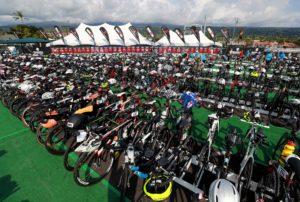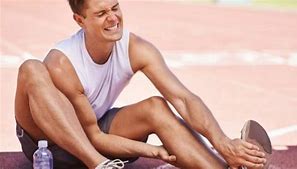By: Raquel Torres
It doesn’t matter how many Triathlons you have competed in everyone has experienced these common things that go wrong. The more important aspect is how are YOU going to handle it when it happens!
Especially for a beginner, you need to know that things do not always go right even for a pro athlete. You can’t let things that go wrong ruin your experience during an event. Part of the challenge of a Triathlon is overcoming situations that are out of our control even including Mother Nature. Triathlons offer many benefits not available in other sports, such as avoiding injuries since you doing a variety of training and a great number of psychological benefits. The satisfaction of improving, resilience and determination are only a few of the many abilities and skills we develop as individuals as we overcome the challenges of a triathlon, thus strengthening our self-esteem. The following situations can happen in a triathlon to anyone regardless of their experience level:
- Getting water in the goggles during the swim. It can happen as another athlete strokes or kicks us and our goggles fall off. Also its common when the googles develop fog and we lose visibility. Solutions: Keep calm, take a deep breath, think positively, find the space to correct what is needed and take your time in this process. It’s better to get the water out or clean the googles than to continue swimming without good visibility, in the long run you will lose more time and energy unless you correct the issue.
- To get lost in the water, bike or run. It can happen in the water as you start to follow another swimmer by aiming at their feet or due to loss of visibility and becoming disoriented. Simple solutions: Stop, re-establish correct direction, swimming straight and breathing in front and using a quick glance in front. On the bike or run it is very common to lose the trail so it is very important to study the route. Remember that it is your responsibility as an athlete to know how many laps you are suppose to do and keep track of how many you have done. We don’t want to leave the trail, do extra laps or less than required and risk disqualification.
 To feel that our breathing rate is accelerated more than the usual or to feel that we are outside our “ideal breathing” rate (It happens to all of us sometimes), due to multiple reasons such as not having a proper warmup, very cold water temperature, starting too fast, nerves or adrenaline. Solutions: deep breaths and positive thinking will help to adjust the breathing rate. In events over 200 meters in open water, experts recommend to breathe every 2 strokes so to give sufficient oxygen to our brain and body. Clarification, this is not recommended for training sessions it is to do during the event in open water and for the first meters.
To feel that our breathing rate is accelerated more than the usual or to feel that we are outside our “ideal breathing” rate (It happens to all of us sometimes), due to multiple reasons such as not having a proper warmup, very cold water temperature, starting too fast, nerves or adrenaline. Solutions: deep breaths and positive thinking will help to adjust the breathing rate. In events over 200 meters in open water, experts recommend to breathe every 2 strokes so to give sufficient oxygen to our brain and body. Clarification, this is not recommended for training sessions it is to do during the event in open water and for the first meters.- The feeling of heavy arms or legs during the swim. (Due to lactic acid accumulation) Solution: Focus on breathing well and with more frequency, give it some time, keep calm and positive as it will subside in a few minutes. If necessary, take a rest by swimming on your back (its legal to also hold on to a boat or kayak to rest).
- Dizziness and loss of visibility after the swim. Loss of balance , tripping or loss of breathing rhythm as you make your way to the bike transition are all very common things as we make the switch from swimming in a horizontal position to running in a vertical stance. Solutions: Remember there is #noshame. If we trip, simply get up, take a deep breath and keep going. It is always a good idea to take our time or pause, I believe that the transition is an opportunity to recover as needed.
- Needing to use the restroom right before the start. Solution: #Adaptation lol. It is good to always carry toilet paper or wipes and try to plan at which moment on race day are we going to stand in line to use the bathroom before the start.
 Not finding the bike or gear when you arrive to the transition. Solution: Keep calm, find an immediate solution or ask for help, always with a positive attitude. Ideally its best to study the bike location and your transition space. This is to be done after we set up all the gear in the transition area before the start. With hundreds of bikes it can be hard to find yours. A tip is to use a bright towel to set your gear on top.
Not finding the bike or gear when you arrive to the transition. Solution: Keep calm, find an immediate solution or ask for help, always with a positive attitude. Ideally its best to study the bike location and your transition space. This is to be done after we set up all the gear in the transition area before the start. With hundreds of bikes it can be hard to find yours. A tip is to use a bright towel to set your gear on top.- Mechanical problems with bike like flat tires. Most events provide some type of technical support, but remember that this help is not always prompt, keep in mind that it may take 10-30 minutes to resolve the problem and in events such as an Olympic Triathlon of over 2 hours it is worth to solve the problem and continue the race. Always remaining calm as we don’t want to spend energy in negative vibes.
- Being afraid on the bike. It could be the downhills, other racers passing close or riding too close, or being afraid to reach for our water bottles. It helps to practice before the race (ride with friends and practice the action of taking your water bottle and drinking from it). Another tip to consider to become more comfortable and sure of yourself is to be deliberatively obvious in your movements as to show other riders what your movement intentions are. Look in all directions before you adjust your position on your bike (in route). It’s important to make your movement and position changes slowly to avoid sudden and unpredictable changes. The rules and riding etiquette are very similar to those of driving a car. It is imperative to read the event rules before the race. This will better prepare you and make you feel more secure in yourself to minimize stress and nerves. Again, in a triathlon, the athletes are exerting themselves greatly and many are beginners. In these conditions, less blood is flowing to the brain and thoughts and reflexes may not be at 100% which necessitates our need to remain alert.
- Back pain, cramps, stomach problems or other digestive problems. (Vomiting or #1 & #2 bathroom needs). It could be a new or existing problem and depending on the race distance and the condition of the athlete many digestive rela
 ted problems can occur. In races of over 2 hours it is required to consume some food along with hydration and for multiple reasons sometimes our body is not able to digest properly. During a strenuous event like triathlons our blood flow to the digestive system is reduced making the process slow and sometimes halting the process. It is critical to practice several sessions taking in the nutrition exactly as we plan to eat during the race. In many events heat may also affect the digestion. Something to also mention here is that many athletes will urinate on the bike or running be it by accident or simply because that is the only option. In many cases of stomach pain the body has the amazing ability to recover and deep breathing always helps. If you get cramps, its ok to stop, stretch, hydrate or take salt tablets or electrolytes. If you get back pain it will help to take short breaks by lifting up from the seat on the bike and also to shift the hand position on the handlebars. To prevent back pain it is important to work on core muscle exercises to strengthen the core such as sit ups, back extension at least 2 times per week. (Ex. Planks)
ted problems can occur. In races of over 2 hours it is required to consume some food along with hydration and for multiple reasons sometimes our body is not able to digest properly. During a strenuous event like triathlons our blood flow to the digestive system is reduced making the process slow and sometimes halting the process. It is critical to practice several sessions taking in the nutrition exactly as we plan to eat during the race. In many events heat may also affect the digestion. Something to also mention here is that many athletes will urinate on the bike or running be it by accident or simply because that is the only option. In many cases of stomach pain the body has the amazing ability to recover and deep breathing always helps. If you get cramps, its ok to stop, stretch, hydrate or take salt tablets or electrolytes. If you get back pain it will help to take short breaks by lifting up from the seat on the bike and also to shift the hand position on the handlebars. To prevent back pain it is important to work on core muscle exercises to strengthen the core such as sit ups, back extension at least 2 times per week. (Ex. Planks) - Start the race too fast. You will later feel as if your body is shutting down. It’s a good idea to practice what is called “Bricks” = When you do two of the disciplines one after the other. (Ex. Bike + Run or Swim + Bike). In a triathlon at the start of the race, the legs will often feel heavy after the bike, so try to start the run with shorter strides than usual and adjust gradually as your body becomes used to the new discipline.
Remember that each and every one of these tips should always be taken with the understanding that they will be applied depending on the person and situation. It’s a priority to always be safe and healthy. The mental mantra will help us stay focused and positive, eliminating stress, increasing relaxation and saving energy. The mind is like the steering wheel of a car, it will go in the direction we dictate and we have the control. To live in well-being, we must steer it in a positive direction.










